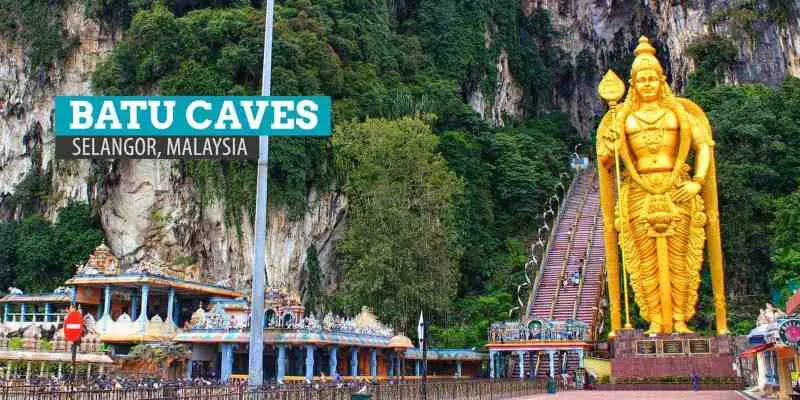
Why Visit Batu Caves?
Batu Caves, standing as one of the most noteworthy travel spots in Malaysia, is a mesmerizing fusion of nature’s splendor, cultural heritage, and spiritual relevance. This limestone formation, home to an intriguing network of caves and cave temples, resides in the Gombak district, roughly 13 kilometers northward of Kuala Lumpur.
Batu Caves holds a prominent place as one of the most visited Hindu sacred sites outside of India, with a special dedication to Lord Murugan, the Hindu deity known as the god of war. The majestic statue of Lord Murugan at the entrance, reaching an impressive height of 42.7 meters, holds the record as the tallest statue of this deity worldwide, creating an immediate sense of wonder in all who behold it. Serving as the centerpiece for the annual Thaipusam Hindu festival in Malaysia, this iconic monument draws millions of worshippers and spectators each year.
Beyond its spiritual magnetism, Batu Caves is also a haven for those with an affinity for nature and adventure. The limestone that constitutes the caves is approximately 400 million years old, marking it as an important site for natural conservation. Moreover, the caves serve as a home to a diverse range of fauna, including a lively group of macaque monkeys that are commonly seen wandering about freely in the area.
Location and Route
Batu Caves, nestled in the northern outskirts of Kuala Lumpur, stands a short drive away from the city’s vibrant heart. Its location makes it readily reachable through a variety of transportation options.
If you’re traveling from Kuala Lumpur City Center, the caves are about a 20-minute drive away. You can use a taxi, Grab, or even rent a car for a self-drive experience. If you prefer public transport, the KTM Komuter train service connects KL Sentral Station with Batu Caves Station, which is a short walk from the cave complex.
From Kuala Lumpur International Airport (KLIA), it’s roughly an hour’s drive to Batu Caves. You can take a taxi or Grab directly to the site, or you can opt for a combination of train services (KLIA Ekspres and KTM Komuter) via KL Sentral.
When to Visit
Batu Caves welcomes visitors all year round. The temple compound typically operates from 6:00 AM to 9:00 PM. The ideal time to explore the caves is during the morning hours, as the weather is more pleasant and the site tends to be less populated.
The most remarkable occasion to experience Batu Caves is during the Thaipusam festival, which usually takes place in late January or early February. This festival transforms the temple complex into a kaleidoscope of colorful processions, ceremonies, and cultural performances. However, it’s important to note that the crowds can be quite immense during this time.
What to See
1. Lord Murugan Statue and the 272 Steps
Upon arrival, the first thing you’ll notice is the gigantic golden statue of Lord Murugan. Right next to the statue are the iconic 272 concrete steps leading up to the entrance of the main cave, known as Temple Cave or Cathedral Cave. Climbing these steps can be quite a feat, but you’ll be rewarded with stunning views and an impressive temple complex inside the cavernous expanse of the cave.
2. Temple Cave
The Temple Cave, being the largest of the cave systems, houses several Hindu shrines beneath its 100-meter high arched ceiling. As you explore this cave, you’ll find various murals and statues depicting Hindu mythology, creating a serene and spiritual ambiance.
3. Dark Cave
For nature and adventure enthusiasts, the Dark Cave offers an exciting exploration opportunity. With guided educational tours, visitors can learn about the cave’s ecology, its unique species, and conservation efforts. The Dark Cave is home to various animals, including bats and spiders, and a remarkable feature known as the ‘Gergasi’ – a stalagmite growing at a rate of one inch every century.
4. Art Gallery Cave and Museum Cave
At the base of the hill, these two caves showcase a collection of Hindu statues and paintings. These exhibits portray stories from Hindu mythology, providing visitors with cultural and religious insights.
5. Rama Cave and Hanuman Statue
The Rama Cave, another important part of the complex, is known for its notable statue of Hanuman, a divine monkey-like figure and devotee of Lord Rama in Hindu mythology. This cave is a site of various devotional ceremonies and features many intriguing Hindu statues and scenes.
In conclusion, a visit to Batu Caves offers a unique blend of religious reverence, natural beauty, and cultural exploration. It presents an excellent opportunity for both spiritual seekers and curious travelers to delve into the depths of one of Malaysia’s most iconic landmarks.



